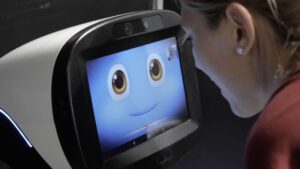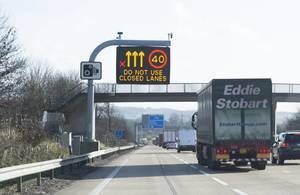The role AI plays in ensuring workplace safety
SHP hears from Sophie Bishop who takes a closer look at how AI is used within health and safety…
Did you know that 37% of companies now incorporate some form of AI into their business processes? Just a few decades ago, artificial intelligence was a futuristic notion that represented a far-off tech-based world. Now, though, it’s our reality.

Credit: Alamy Stock
AI is one of the most exciting, innovative technologies currently available, making it no surprise that businesses are jumping at the chance to try it out. From more efficient processes to reductions in human error, it’s likely to transform the way we think about work. But what about safety? If you’re interested in how AI could improve the security of your business and the health of your staff, we’ve got everything you need to know.
What is Artificial Intelligence?
AI is a form of computer science that’s aimed towards making machines as capable – and sometimes more capable – of performing certain tasks as humans. These machines are modelled on the human brain, matching or improving our capabilities and foreseeing our needs. The aim of AI is to remove labour from people, transferring menial jobs to computers.
AI is beginning to infiltrate pretty much every industry out there, including the safety sector for construction and manufacturing sites. Highly futuristic and a technology unlike anything we’ve seen before, it’s one of the most exciting developments of the modern age.
How is AI used in workplace safety?
Anticipating future incidents
One of the primary uses of AI in the construction industry is data analytics. AI technology can scour through hundreds of inputs and outputs in a matter of minutes, finding anomalies and patterns, and creating predictions. One of the main uses of this when monitoring safety on-site is to anticipate potentially dangerous incidents before they occur.
AI can take into account a number of factors in the situation, such as the equipment being used, site conditions, and the experience of your workers. It can correlate this with past accidents, finding similar situations where incidents occurred. For example, it may be that when a certain piece of machinery was used in freezing temperatures, it malfunctioned on multiple occasions, resulting in potential injuries. You can then either switch this piece of machinery for one better suited to cold weather or focus on work in other areas when temperatures drop below 0°C.
AI can also anticipate equipment malfunctions. As you feed data from your machinery into AI systems, they can detect abnormalities and quickly alert you of potential problems.
Predicting equipment malfunctions and breakdowns
In a similar way to predicting accidents, AI can also anticipate equipment malfunctions. Data fed directly from your machinery into AI systems can be thoroughly analysed in a number of ways. The first is by looking at the history of the machinery. AI may notice patterns of a component malfunctioning after a set time of use, and alert your systems when it’s expected to need replacing again based on this.
AI can also monitor the condition of your machinery. Abnormalities in performance can be quickly detected to alert you of a potential problem within the machinery, allowing you to quickly change it before an accident occurs. As you feed data from a safety inspection app into AI systems, for example, they can detect abnormalities and quickly alert you of potential risks and problems.
Operating self-driving vehicles
The futuristic self-driving vehicle is already appearing on our streets and on construction sites. These vehicles are still in the fairly early stages of development and aren’t widely used yet, but it’s expected that will change over the next decade or so.
In theory (though yet to be properly put to the test), self-driving vehicles on a construction or manufacturing site will be safer than those driven by humans. AI can react quicker than humans can, so if an obstacle – such as an employee – appears in front of the vehicle, it should be able to stop quicker. It’s also crucial to note that at least 90% of crashes are due to human error, such as texting whilst driving or forgetting to indicate. AI is programmed to avoid such mistakes, making it a safer option.
Of course, more testing and development must be done before the safety of AI self-driving vehicles is confirmed, but it does look likely that they’ll be a safer option than human-driven machinery.
Assessing site safety

AI has become capable of identifying images and understanding what they mean. It can recognise and analyse a whole variety of data from the images, too, including the time of day and the context of the image. Pair this with drone footage, and you can use AI to thoroughly and quickly assess site safety.
You can see the potential of AI image recognition through the AI Motorway Scheme. Though not up and running yet, the plan is to use AI to visually monitor traffic and the trajectory of cars on the road. It can then predict issues, such as a build-up of traffic on a road further up or a car driving dangerously, and be used to prevent collisions.
AI in the workplace is used similarly. By monitoring images from drones, it can be programmed to spot areas of structural damage, potential vehicle collisions, or too many staff in one area.
Benefits of incorporating AI
The uses of AI in safety are almost endless. Those we’ve mentioned here are just a handful of the opportunities we expect AI to help with. But why implement AI in the first place, and is it really better than human intelligence? Let’s take a look.
24/7 capabilities
One of the obvious benefits of AI is that it doesn’t tire. You can have data analysis running 24/7 without pausing for 365 days of the year. Your site can be constantly assessed, and the safety of your staff monitored at all times, which just isn’t capable with humans.
Better data analysis
Statistical analysis conducted by humans is far more flawed than that done by AI. AI, for example, doesn’t need to know underlying factors of data like probability distribution and can quickly analyse and make predictions based on inputs and outputs alone. It also doesn’t leave room for human error, such as misreading a number or skipping a page. This allows for safety measures that were impossible before machine learning.
Unbiased decisions
AI isn’t biased in the same way that humans are. It’s not worried about money or thinking about how certain changes may create more work for itself. Instead, it’s purely focused on showing you how you can create a safer environment for your staff, making it more reliable than humans.
Is AI a likely reality?
AI isn’t a far-fetched, futuristic notion. In fact, it’s already being implemented in construction and manufacturing sites around the world, and the development of new tools is constantly taking place. Tools like Siri, image recognition for face unlock, and social media algorithms are implementing AI right now, and that’s just within the context of your phone!
Manufacturing robots, self-driving vehicles, and smart assistants are in place in the workplace, too. There’s no doubt that AI is becoming a part of daily life, and in ten or twenty years, it’s likely that the safety of your workplace will be largely in its hands.
Final words
Safety in the construction and manufacturing industries has always been an important issue. Now, with new technologies innovating how we train staff, monitor sites, and anticipate hazards, the sites we work on can become safer than ever. Hopefully, this article has given you an insight into just how much technology is transforming industries and inspired you to implement your own digital safety methods.
The role AI plays in ensuring workplace safety
SHP hears from Sophie Bishop who takes a closer look at how AI is used within health and safety...
Sophie Bishop
SHP - Health and Safety News, Legislation, PPE, CPD and Resources Related Topics
How will AI transform health and safety?
Unleashing the power of emerging technologies in EHS
Elevating EHS in an era of global trends and regulations


